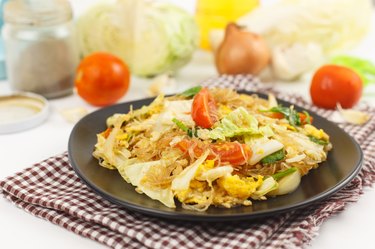
Mung bean noodles are widely used throughout China and Southeast Asia. They are an ingredient in many Oriental food dishes, such as soups, stir-fries, salads, desserts and spring rolls. The noodles themselves are flavorless but readily absorb the flavors of other ingredients added to the dish. Even eaten alone, mung bean noodles contain many nutrients important to your overall health.
Identification
Video of the Day
Mung bean noodles are also called glass noodles, cellophane, thread or moong bean noodles. Made of mung beans, these noodles have a gelatinous thread-like structure and are usually folded into bundles for retail distribution. Uncooked mung bean noodles are translucent, but they become more opaque the longer they are cooked. Their cooked structure and consistency is retained, unlike wheat and rice noodles.
Video of the Day
Calorie Content
Mung bean noodles contain 491 calories per cup, almost all from the high carbohydrate content of 121 grams per cup. Eating 1 cup of plain mung bean noodles fulfills 1/4 of your average daily calorie needs. Mung bean noodles contain no sugar or cholesterol and less than a gram of fat. They are low in sodium with 14 milligrams per cup.
B Vitamins
Mung bean noodles contain the B vitamins thiamin, niacin, pantothenic acid, vitamin B-6 and folate. The B family of vitamins is essential for the formation and maintenance of cells in the body, especially nerve cells. They are critical nutrients for energy and brain activity, including mood and memory. Folate is especially important for the production of red blood cells and helps prevent birth defects and abnormalities to the brain and spine in the fetus, such as spina bifida. Mung bean noodles contain 3 micrograms of folate per cup.
Choline
Choline assists with the development of the brain, including memory. It is essential for normal cell activity, liver function and nutrient absorption. Mung bean noodles provide 131 milligrams per cup, which is 24 to 31 percent of the daily recommended intake, or AI -- 550 milligrams for men and 425 milligrams for women, according to the Food and Nutrition Board of the Institute of Medicine.
Minerals
Calcium and phosphorus are important minerals for strong bones and teeth. Mung bean noodles contain 35 milligrams and 45 milligrams per cup, respectively. With 3 milligrams per cup, noodles provide iron necessary to carry oxygen to cells. Mung bean noodles are a good source of selenium and provide about 20 percent of the recommended dietary allowance per cup. Other minerals in mung bean noodles include zinc, copper and magnesium.
Glycemic Index
Foods, such as mung bean noodles, that contain mostly carbohydrates are digested quickly and are usually rated high on the glycemic index, or GI, a measurement of the effect a food has on blood glucose. High glycemic foods elevate insulin and blood glucose and may increase the risk of diabetes. Researchers at the National Pingtung University of Science and Technology in Taiwan discovered that mung bean noodles were among the lowest on the GI index of high-carbohydrate foods eaten in Chinese diets. They used 10 subjects to evaluate the glycemic index and found mung bean noodles to have a lower glycermic index than brown rice, taro, adlay, yam and bread. Conclusions, published in 2010 in the "World of Gastroenterology," suggested values and management of starchy foods in the diet are useful for the prevention of lifestyle-related health issues, such as diabetes mellitus.
- Food Recipes: Thai Food: Glass Noodles; About Mung Bean Noodles Or Thread Noodles
- USDA National Nutrient Database
- The Vitamins and Nutrition Center: B Vitamins-Eneregy; Dr. George Obikoya
- National Institutes of Heath: Office of Dietary Supplements; Folate
- The GI Diet: High, Medium and Low GI Foods; Glycemic Index
- “World of Gastroenterology”; Glycemic Index, Glycemic Load and Insulinemic Index of Chinese Starchy Foods; M.H. Lin, et al; 2010